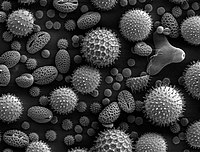
Photo from wikipedia
Graphitic carbon nitrides (commonly referred to as g-CNxHy or g-C3N4) have recently garnered interest due to their visible-light activity for photocatalytic water reduction [1]. Similar to graphite, g-CNxHy has a… Click to show full abstract
Graphitic carbon nitrides (commonly referred to as g-CNxHy or g-C3N4) have recently garnered interest due to their visible-light activity for photocatalytic water reduction [1]. Similar to graphite, g-CNxHy has a hexagonally symmetric in-plane structure but with periodic replacement of C-atoms with N-atoms resulting in bandgap formation and regular voids within the layers. Due to the synthesis strategy, residual hydrogen becomes trapped in the structure thus preventing long range planar order [2]. Because g-CNxHy is extremely beam sensitive, conventional high dose imaging with transmission electron microscopy (TEM) renders the material amorphous [3]. However, by combining low electron doses with direct electron detectors, the structure of g-CNxHy can be imaged using high-resolution TEM.
Journal Title: Microscopy and Microanalysis
Year Published: 2017
Link to full text (if available)
Share on Social Media: Sign Up to like & get
recommendations!